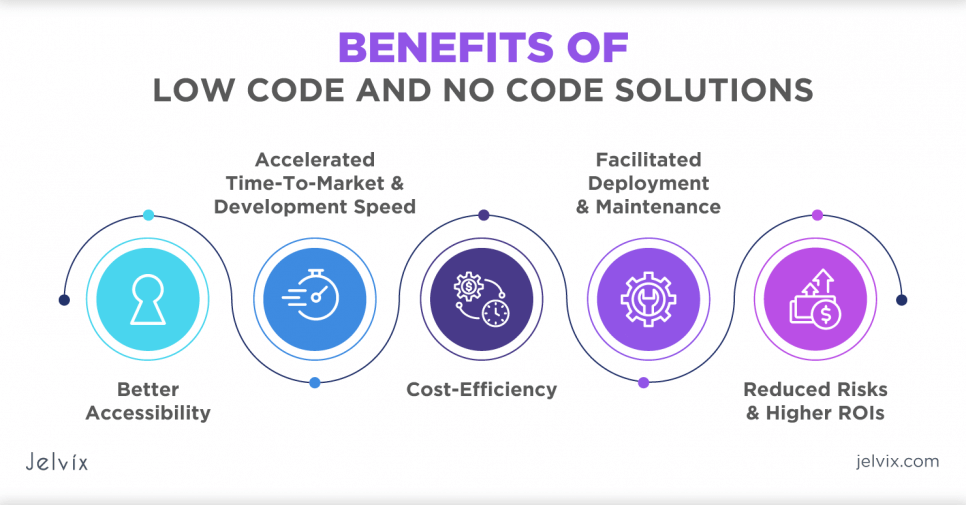The Future of Software Development: Trends to Watch in 2025

The Future of Software Development: Trends to Watch in 2025
Explore the hottest software development trends for the year 2025-from AI and cloud computing to blockchain and 5G, with which to keep ahead of the ever-changing tech landscape.
In the ever-evolving world of technology, keeping up with the latest software trends is essential. Being updated with the latest tech allows you to make pragmatic and proactive decisions for your business.
Software development has been around for over a decade now, and it can potentially boost a business's online presence. Therefore, it is essential to be informed about the upcoming trends in software development.
Research shows that the software development industry will reach $738.96 billion by 2025. These numbers show that software development has not reached its full potential yet, and there is much more to come!
In this blog, we will discuss the latest trends in software development to keep an account of in 2025.
Software Development Trends in 2025
The software development realm is constantly evolving due to new innovations. Here are the main software development trends you must know:
Artificial Intelligence & Machine Learning
Artificial intelligence and machine learning have been integral to software development for a long time.
From automating tasks to enhancing decision-making, AI-powered solutions have revolutionized many different domains. In software development, code generation, debugging, testing, and optimization are all areas of AI application. Here’s how AI can power your tools and processes:
- AI-Powered Development Tools: AI-based tools like GitHub, Copilot, and OpenAI Codex help developers write faster and with fewer defects.
- Predictive Analytics: AI allows for predictive analytics for the best choices to optimize software performance in organizations.
- Natural Language Processing (NLP): AI employs chatbots and virtual assistants to improve customer support and user engagement.
- Automated Testing: AI and ML technologies help with automated software testing, which detects defects and predicts failures in real time.
- AI-based Cyber Security: AI offers security by identifying vulnerabilities and potential threats in applications before they become significant risks.
- AI in DevOps: AI speeds up DevOps processes by automating workflows, optimizing resource usage, and clearing development backlogs.
As AI models improve, they will play a more active role and soon lead to advanced applications.
Cloud Computing
Cloud computing has redefined software development. It offers highly scalable, cost-effective, and available-on-demand resources. Companies are now turning to cloud computing technologies to increase their business flexibility and cut infrastructure costs. These are some ways cloud computing impacts IT processes and functions:
- Multi-cloud and Hybrid Cloud Strategies: Multi-cloud and hybrid cloud environments are adopted by organizations to deal with vendor lock-in and improve dependability.
- Cloud-Native Development: It allows microservices and containerization, which is still an agile and scalable cloud-native development.
- Edge Computing: Supplemental to the cloud and allows for closer data processing to the source, lowering latency and improving response time.
- AI and Cloud Interdependency: Cloud services powered by AI catalyze automated tasks, access better cloud security, and optimize resources.
- Convergences in Cloud Security: Emerging trends in encoding, Zero Trust model, and compliance areas boost cloud security.

Within serverless computing, serverless architectures permit developers to create and deploy applications without worrying about the actual servers upon which they run, greatly reducing software operational overhead.
Cloud computing remains businesses' backbone of digital transformation, allowing them to scale and innovate faster.
5G Technology
The onset of 5G has opened new avenues in software development, where ultra-low latency and high-speed connectivity bring in their wake next-generation applications. Look at how 5G technology fosters more innovation:
- Enhanced Mobile Applications: 5G introduces a new level of richness and interactivity in mobile experiences with HD streaming and multiplayer mobile gaming.
- Internet of Things (IoT) Expansion: 5G enriches connectivity with many IoT devices for more automated and smarter applications.
- Cloud Gaming and AR/VR Applications: 5G has supported some cloud gaming and augmented/virtual reality experiences by increasing bandwidth and reducing latency.
- Smart Cities and Autonomous Vehicles: 5G will supply the backbone for the infrastructure enabling solutions for smart city development and improved urban mobility.
- Enabling Remote Work and Collaboration: 5G will allow super-enhanced video conferencing, with real-time data sharing for seamless collaboration among distributed teams.
- Healthcare: 5G connects and facilitates remote surgeries, telemedicine, and real-time patient monitoring through connected medical devices.
As 5G grows into an existing reality, its magnitude for software development will ever increase, thus driving innovation in several industries.
Progressive Web Applications (PWAs)
Progressive Web Apps have proved to be the best hybrid alternatives to web and mobile applications today. They successfully smoothen users' experiences by integrating better features between a web and a native application. PWAs elevate key processes and functions such as:
- No-Internet Usage: This app will continue working in offline mode because service workers provide the facility that way; a perfect navigational experience can be ensured.
- High Performance: Enhancing speedy download time and fast response time drastically increases their engagement quotient with satisfied customers.
- Ability to Work on Any Device: It eliminates the need to separately develop PWAs for different devices and platforms.
- Lower Development Cost: This greatly reduces the total cost of development and maintenance of such applications compared to the cost of traditional mobile applications.
- SEO Advantages: A website's increased discoverability is enhanced by being indexed by search engines, which somewhat increases traffic and, consequently, engagement.
- Security Enhancements: PWAs utilize HTTPS to secure the data a user sends and receives. Thus, traditional web applications are less vulnerable than it is.
Because of continued advances in their popularity, PWAs will change the face of the mobile applications industry forever and offer businesses a cost-efficient way to develop an application compared to native apps.
Blockchain Technology
Blockchain is gradually traversing the boundaries of cryptocurrencies to ensure increased security, transparency, and efficacy in software development.
Moreover, the blockchain market is expected to grow substantially, moving towards $291 billion by 2030, as 73% of executives acknowledge its competitive benefits. Explore how blockchain changes the game:
- Decentralized Application (DApp): Blockchain is a foundation for building secure and tamper-resistant decentralized applications.
- Smart Contracts: Self-executing smart contracts automate the process, with less need for intermediaries.
- Enhanced Security: Blockchain's immutable ledger ensures the integrity of the data and is, therefore, preferred in the case of financial and supply chain applications.
- Tokenization: Using tokenizing assets through Blockchain leads to more secure and transparent transactions.
- Identity Management: With blockchain, authentication, and access control are improved to help fight against fraud and identity theft.
- Interoperability Solutions: Newer interoperability solutions enable cross-chain compatibility for effortless communication across various blockchain networks.
As new developments are witnessed, the massive acceptance of this technology for use in software development is likely to create avenues for innovations in various fields.
Internet of Things (IoT)
The Internet of Things is a network of devices interlinked, enabling data interchange in real-time, thus transforming industries. Software development for IoT propels smart ecosystems.
Research shows that from 2018 to 2025, the Internet of Things will face an increase of 65 billion IoT products, growing sixfold. Here are ingenious ways IoT improves connectivity:
- Smart Homes and Wearables: IoT applications are found in smart homes and wearable devices, giving convenience and efficiency.
- Industrial IoT (IIoT): IoT improves manufacturing, predictive maintenance, and automation through solution optimization.
- Connected Healthcare: IoT-associated medical devices, remote monitoring, and more benefit patient care and health outcomes.
- Security and Privacy Concerns: With the expanding IoT, cybersecurity measures have become the top priority to prevent data breaches.
- IoT and AI Convergence: By analyzing data, AI helps make the IoT more intelligent, along with predictive analytics.
- IoT Standards: New protocols and regulations are emerging towards better interoperability and security across the IoT ecosystem.
Low-Code and No-Code Deployment
Low-code and no-code platforms serve as a fast-moving, program-based application development arena while looking past everyday programming.
With a potential market value of $46.4 billion by 2026, no code/low code is becoming a serious trend. These are some advancements and benefits brought by no-code and low-code development:
- Citizen Developers: Grants non-techies the leverage to engineer their applications.
- Business Agility: Allows for swift adjustment to the changing market needs.
- Enterprise Adoption: Group organizations utilize low-code solutions to enhance workflow automation.

Augmented Reality (AR) and Virtual Reality (VR)
AR and VR enhance immersive digital experiences across industries. These technologies aren’t new but they are certainly shaping the future for the following:
- Virtual Training: AR/VR revolutionizes employee training programs.
- Remote Assistance: AR aids in real-time remote troubleshooting.
- Healthcare Applications: VR simulations assist in medical surgeries and rehabilitation.
FinOps and GreenOps
With the rapid pace of modernization in the cloud computing scene, FinOps and GreenOps can be heard gradually asserting their rights as the latest software development trends.
- FinOps: The art of balancing cloud costs with performance optimization.
- GreenOps: Focused on sustainable IT infrastructure and energy efficiency.
The Rise of DevSecOps
DevSecOps refers to an automation platform that is designed to integrate and enhance security in the IT world we live in. It consists of the following:
- Security First Development: Integrates security within DevOps workflows.
- Compliance Automation: Regulatory compliance is maintained through automated security checks.
- Threat Mitigation: Use of real-time security monitoring to fend off vulnerabilities.
Stay at the Forefront of Software Development
In today's rapidly changing world of technology, software development trends are crucial for companies that want to maintain their height in innovation and efficiency. It is clear that the fast-growing AI and cloud computing, blockchain and IoT, and other emergent trends, have huge prospects in the house.
The latest advancements create good digital experiences while streamlining operations that lead to business success. The peak prospect thrown by the software development industry is enough to ensure that companies that pay heed and adapt to emerging trends will earn a niche with time. Indeed, by implementing cutting-edge technology, businesses will strengthen their resilience to continue adapting and growing in a mostly digitalized world.
